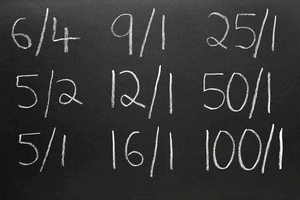 One of the sensible things that intelligent bettors like to do is work out the margins that a bookmaker gets on a certain wager. This is because it helps them to realise the bets that they should avoid, given the fact that a large margin built into a wager typically suggests that it is poor value.
One of the sensible things that intelligent bettors like to do is work out the margins that a bookmaker gets on a certain wager. This is because it helps them to realise the bets that they should avoid, given the fact that a large margin built into a wager typically suggests that it is poor value.
Bookies offer odds that are lower than the actual likelihood of something happening, which is how they’re able to make money. This ‘margin’ is built into bets automatically but the amount that they’re able to make will differ from bet to bet.
Working out the margin on bets that have a fixed outcome, such as the Home, Away or Draw wager, is relatively easy. Doing so on a bet that has a number of moving parts and multiple possible outcomes is much harder.
Indeed, on the likes of a Goalscorer wager, it is virtually impossible to figure out what a bookmaker’s margin will be, which perhaps tells you that it is not the sort of best that you should be placing on a regular basis. Add in the fact that many will add such a selection to an acca and you can see how bookies make money.
Use Decimals When Working Out Margins
 The first thing to say on the discussion around margins is that it is always much easier to calculate them when you use decimal odds rather than fractional. Fractional odds might be the ones chosen by British bookmakers, but it is much harder to apply a formula to them than it is with decimal odds. It’s relatively easy to convert fractional odds to decimal, but even if that is something that you’re not particularly good at then you don’t need to worry: there are a wealth of websites out that there will do the hard work for you on that front.
The first thing to say on the discussion around margins is that it is always much easier to calculate them when you use decimal odds rather than fractional. Fractional odds might be the ones chosen by British bookmakers, but it is much harder to apply a formula to them than it is with decimal odds. It’s relatively easy to convert fractional odds to decimal, but even if that is something that you’re not particularly good at then you don’t need to worry: there are a wealth of websites out that there will do the hard work for you on that front.
When trying to work out a bookie’s margin, the following formula is what you will want to use:
(1/decimal odds) x 100 + (1 decimal odds) x 100
Let’s imagine that you’re watching a tennis match in which the odds for one player are 1.54 whilst the odds for their opponent are 2.48. In that instance, the formula would be as follows:
(1/2.48) x 100 + (1/1.54) x 100 = 40.3 + 64.9 = 105.2
Because we know that 100 is the actual possibility of one or the other player winning, we can see that the bookmaker’s margin in this specific instance is 5.2%. Anything over 100 when doing such a calculation is the bookie’s margin, regardless of what the odds are. Say the odds were 1.50 and 2.50 instead, the formula would then be as follows:
(1/2.50) x 100 + (1/1.50) x 100 = 40 + 66.6 = 106.6
Here you’ll see that the margin for this bookmaker is 6.6%. The bookmaker offering the first odds is making 1.14% less than the other bookie, meaning that you’re getting slightly better value with them. Calculating such value is another reason why it is helpful to know what a bookmaker’s margin is. Used correctly, it can help you work out whether you’re getting better value with one bookie over another. It can also help you to realise when a bookmaker is taking the Mickey out of you with the money that they’re making from you.
More Complicated Markets
 It is possible to calculate the margin of slightly more complicated markets, but not to the extent of Correct Score or First Goalscorer wagers. If you’re looking at the possible outcome of the match, often referred to as the 1X2 market, you can use another formula to help you to get to the place that you need to be to figure out the margin. The formula is now as follows:
It is possible to calculate the margin of slightly more complicated markets, but not to the extent of Correct Score or First Goalscorer wagers. If you’re looking at the possible outcome of the match, often referred to as the 1X2 market, you can use another formula to help you to get to the place that you need to be to figure out the margin. The formula is now as follows:
(1/home odds) x 100 + (1/draw odds) x 100 + (1/away odds) x 100
In order to demonstrate that more effectively, let’s imagine that you’re considering betting on a match between Manchester City and Manchester United. City are the superior team in the eyes of the bookmakers, so they’ve been offered odds of 1.75. United, meanwhile, are underperforming and are offered at odds of 3.70. The draw, meanwhile, is 3.95, meaning that our formula now becomes the following:
(1/1.75). 100 + (1/3.70) x 100 + (1/3.95) = 57.1 + 27 + 25.3 = 109.4
You can see that the bookmaker’s margin is 9.4%, with the outcome once again adding up to 100 as there will definitely be a result. Anything over 100 is therefore the margin of the bookie. You can presumably now see why it is that trying to calculate the margin on something as complex as a Goalscorer market is extremely difficult to do. There is no simple formula to help calculate such a margin, so instead it is better to think of it in more wide-ranging ways.
Goalscorer markets are further complicated by the fact that there can be be players on and off the pitch that can score. The odds offered before the match line-up is announced will be different to those after the formations are released because at this point the bookies know the starting players and will reduce the odds accordingly. Therefore the odds and margins are constantly shifting on the whole market and even if you could calculate the margin it would only be a short snapshot of the market before it changes.
Even once the line-up is announced it is not easy to calculate a margin. Yes you know the 22 players on the pitch and could perform the equation we showed you earlier to work out the margin on the starting players, but this won’t factor in players who can come on as a sub and still score and affect the market. Goalscorer odds are almost exclusively calculated using computer algorithms by bookies, which in itself shows you how hard it is to do it yourself.
Generally betting on goalscorers before a line-up is announced can give better odds, as the uncertainty around starting is often factored in. It is also more risky, though, as that player may not start. If they do not play at all or come on after a goalscorer bet has already settled (e.g. first goalscorer) then your bet will be void and you get your stake back, if they come on as a sub, however, they can still score so your bet will still stand (e.g. anytime or last goalscorer or first goalscorer if there hasn’t been a goal yet). There is less time for the player to score a goal in this scenario, making that bet more risky and lower value.
Ultimately goalscorer bets are highly variable markets and this means that bookies under-price them, they operate bigger margins in general to allow for that variation. Therefore, on the whole goalscorer bets should be avoided
Highly Variable Markets Are Poor Value
 Whilst we can’t offer you a formula that helps to calculate the margin of a Goalscorer bet, what we can do is tell you that it is poor value. Even when you look at the likes of Mohamed Salah, who scored 32 goals in a 38-game season for Liverpool during the 2017-2018 campaign, he didn’t score in every single match that the Merseyside club played. Indeed, the record for consecutive goals scored is 11, notched up by Jamie Vardy for Leicester City between the 29th of August and the 28th of November in 2015.
Whilst we can’t offer you a formula that helps to calculate the margin of a Goalscorer bet, what we can do is tell you that it is poor value. Even when you look at the likes of Mohamed Salah, who scored 32 goals in a 38-game season for Liverpool during the 2017-2018 campaign, he didn’t score in every single match that the Merseyside club played. Indeed, the record for consecutive goals scored is 11, notched up by Jamie Vardy for Leicester City between the 29th of August and the 28th of November in 2015.
In other words, even the very best players in the world are unlikely to score every single time that they take to the pitch, so a bookmaker offering odds such as 4/7 for a player to score Anytime during a match is ridiculous. It is a bookmaker knowing that people will feel an emotional connection to the idea of a player putting the ball into the back of the net and will therefore take virtually any odds that they’re offered. This, in turn, means that said bookies can make their own margin on such a bet astronomical, relatively speaking.
When you start going down the road of related contingency bets, such as Wincast or Scorecast, the number of things that need to happen for your wager to be a winner increases exponentially and so does the bookmaker’s margin. The same is true of accumulator bets at the best of times, let alone when you start adding in Goalscorer bets as one of the legs of the acca that you’re placing. The margin is huge, meaning that the bet is not a good value one to place.
That being said, bets with a high margin for the bookmaker are also ones that will offer a big payout for punters. If you don’t mind losing bets that stand to win you a lot of money if they come in, the likelihood is that you’re not going to care much about how big the bookies’ margin is. In this instance, Goalscorer bets are just as good a one to add to your betting slip as anything else. Just know that every time you lose, your handing your bookie of choice large sums of money that should really be yours.